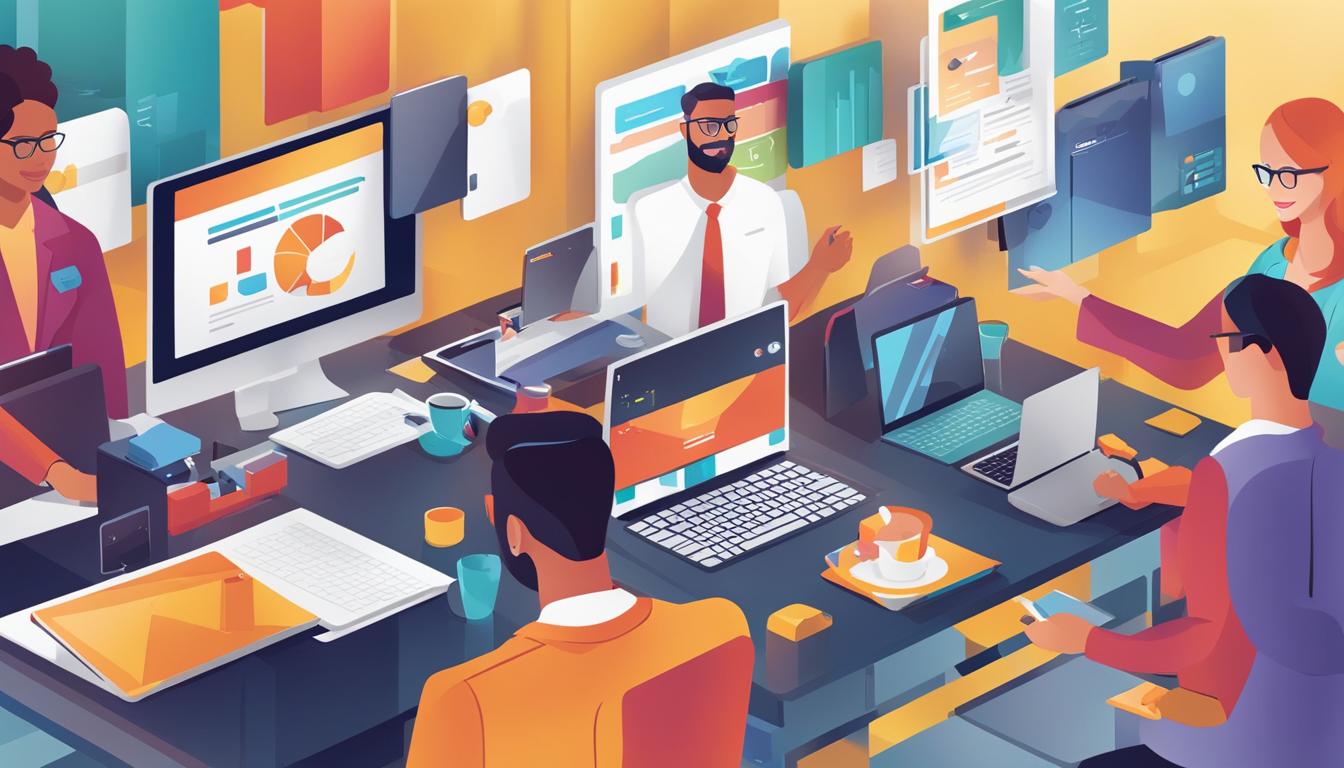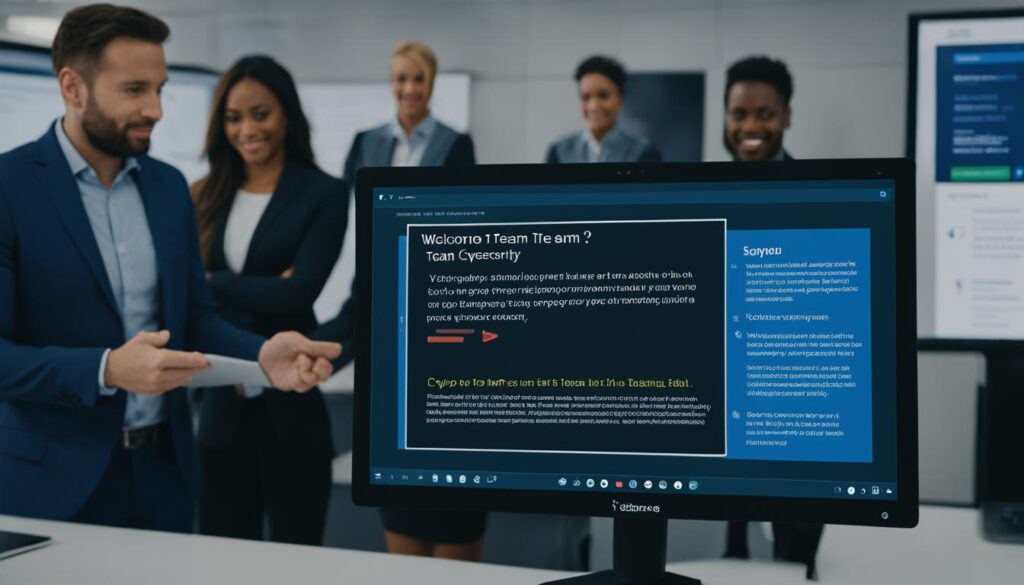Did you know that companies with a standardized onboarding process experience 54% greater new hire productivity? That’s just one of the many reasons why digital employee onboarding has become a game-changer in today’s fast-paced business world.
Traditional employee onboarding processes often involve in-person courses and meetings, which can be time-consuming and costly. However, with the emergence of digital onboarding tools and software, companies now have the opportunity to streamline and enhance the onboarding experience for new hires.
In this article, we’ll explore the advantages, challenges, and tools associated with digital employee onboarding. Whether you’re an HR professional looking to optimize your onboarding process or a new hire curious about the benefits of digital onboarding, this article has you covered.
Key Takeaways:
- Digital employee onboarding can significantly improve new hire productivity compared to traditional methods.
- Traditional onboarding processes often involve in-person courses and meetings, which can be time-consuming and costly.
- Digital onboarding tools and software offer advantages such as improved efficiency, cost reduction, and greater convenience.
- Challenges associated with digital onboarding include new employees feeling isolated and experiencing information overload.
- To optimize the digital onboarding process, companies can use different types of content, make new hires feel like part of the team, and utilize dedicated onboarding apps.
Benefits of Digital Onboarding
Digital employee onboarding offers numerous advantages over traditional onboarding methods, providing a streamlined and efficient process for welcoming new employees. By leveraging onboarding software and technology, companies can achieve cost reduction, improved efficiency, and enhanced convenience throughout the employee onboarding process.
Automated Tasks and Reduced Paperwork
With digital onboarding, the need for manual paperwork and in-person training sessions is eliminated. This automation allows for faster onboarding by automating repetitive tasks and reducing administrative burden. All necessary information and documents can be stored in a centralized database, easily accessible by new hires. This not only saves costs associated with printing and storing physical documents but also ensures a more secure and organized onboarding experience for both employees and HR departments.
Comprehensive Online Training Courses
Digital onboarding software enables companies to create and publish comprehensive online training courses that can be completed remotely. This reduces the reliance on in-person training sessions, saving time and resources. New hires can access the training materials at their convenience, allowing them to progress through the onboarding process at their own pace. By providing self-paced training courses, companies can ensure that new employees receive consistent and standardized training regardless of their start date.
Improved Efficiency and Time Savings
The use of digital onboarding can significantly improve efficiency by eliminating manual tasks, reducing paperwork, and accelerating the onboarding process. By digitizing forms, documents, and HR processes, companies streamline the entire onboarding workflow, resulting in time savings for both HR departments and new hires. Digital onboarding creates a more streamlined and efficient experience, enabling HR professionals to focus on building relationships and providing personalized support to new employees.
Enhanced Convenience and Flexibility
Digital onboarding offers new hires greater convenience and flexibility. Instead of attending multiple in-person meetings and training sessions, employees can complete the onboarding process from anywhere with an internet connection. This flexibility allows new hires to balance their onboarding activities with other commitments, ensuring a smoother transition into their new roles. Additionally, digital onboarding provides 24/7 access to important information and resources, empowering employees to engage with the onboarding process at their convenience.
Implementing digital employee onboarding not only improves the onboarding experience for new hires but also benefits companies in terms of cost reduction, improved efficiency, and increased convenience. By embracing technology and utilizing onboarding software, organizations can create a seamless and effective onboarding process that sets new employees up for success from day one.
Challenges of Digital Onboarding
While digital onboarding offers many advantages, there are also challenges that companies need to address. One challenge is the potential for new employees to feel isolated, as they do not have in-person interactions with managers and team members. This lack of face-to-face communication may make them feel disconnected and hinder their ability to build relationships within the organization.
Another challenge is the risk of information overload. The digital onboarding process often involves presenting new hires with a considerable amount of information, such as company policies, procedures, and job-specific details. This overload of information can be overwhelming for new employees, making it difficult for them to absorb and retain crucial information.
To mitigate these challenges, companies can adopt certain strategies. Regular check-ins with new hires provide an opportunity for feedback, questions, and clarification, fostering a sense of support and connection. Providing virtual channels for communication and collaboration, such as video conferencing and team chat platforms, helps alleviate feelings of isolation and promote engagement among new employees.
Another effective approach is to deliver information in bite-sized, easily digestible chunks. Breaking down complex topics into smaller modules or using interactive training tools can help prevent information overload and enhance knowledge retention.
By addressing the challenges of isolation and information overload inherent in digital onboarding, companies can create a more inclusive, interactive, and effective onboarding experience for new employees.
Optimizing the Digital Onboarding Process
To ensure a seamless and efficient digital employee onboarding process, companies can implement several strategies. By utilizing different types of content, such as videos, quizzes, and interactive elements, you can make the onboarding experience engaging and interesting for new hires.
Making new employees feel like part of the team from day one is crucial for their integration into the company culture and their ability to build relationships with their colleagues. Encourage open communication and collaboration, and provide opportunities for new hires to interact with their team members. This will help them feel welcomed and supported throughout their onboarding journey.
One effective way to streamline the process is by utilizing a dedicated onboarding app. This software can provide new hires with all the necessary resources and support they need in one centralized platform. From accessing important documents and training materials to connecting with mentors and managers, a dedicated onboarding app simplifies and enhances the overall onboarding experience.
Finding the Right Digital Onboarding Tools
To optimize the digital onboarding process, it’s essential to select the right onboarding software that suits your organization’s needs. Look for software that offers customizable features, allowing you to tailor the onboarding process to match your company’s culture and values.
Additionally, consider onboarding tools that offer communication channels, such as video conferencing, chatbots, and interactive websites. These tools enable effective virtual meetings, quick responses to common employee questions, and easy access to important information and training activities.
Remember, the goal of optimizing the digital onboarding process is to create an efficient and personalized experience for new hires. By utilizing the right tools and strategies, you can ensure that your employees start off on the right foot and feel confident in their new roles.
Importance of Proper Employee Onboarding
Effective employee onboarding is crucial to ensuring the success and engagement of new hires in their roles. Proper onboarding provides them with the necessary knowledge and resources to understand their responsibilities, align with team and company goals, and integrate into the company culture. Without a well-designed onboarding process, new employees may struggle to find their place and become disengaged, which can have negative impacts on their productivity and job satisfaction.
By implementing digital employee onboarding, companies can create a positive onboarding experience that sets new hires up for success. Digital onboarding solutions provide an efficient and accessible platform for delivering necessary information and support, enabling new employees to quickly acclimate to their roles and feel supported from day one.
The onboarding process should focus on introducing new hires to the company’s mission, values, and expectations. This helps them understand the bigger picture and how their role contributes to the overall success of the organization. Through effective onboarding, companies can instill a strong sense of purpose and belonging in new hires, which enhances their motivation and commitment to the company.
Benefits of Proper Employee Onboarding:
- Improved employee retention: A comprehensive onboarding process helps new employees feel valued, engaged, and connected to the organization, increasing their likelihood of staying with the company in the long term.
- Enhanced productivity: By providing new hires with the necessary resources, training, and support, companies can expedite their ramp-up time and minimize the time it takes for them to become fully productive contributors.
- Positive company culture: Onboarding offers an opportunity to showcase the company’s culture and values, enabling new employees to align with and embody these principles from the beginning.
- Reduced turnover costs: Effective onboarding reduces the likelihood of new hires leaving the organization within the first few months, saving the company the costs associated with recruiting, hiring, and training replacements.
Proper employee onboarding, whether done in person or digitally, is essential for helping new hires transition smoothly into their roles. By utilizing digital onboarding solutions, companies can enhance the onboarding experience, facilitate knowledge transfer, and foster a sense of belonging. This ultimately leads to higher employee satisfaction, increased retention, and improved performance.

Digital Onboarding in Practice
Digital employee onboarding allows companies to streamline the onboarding process by leveraging web- or mobile-based onboarding software. With this approach, your organization can create and publish a customized onboarding program that encompasses various components such as training courses, team introductions, policy sharing, and documentation collection.
By utilizing web-based onboarding software, you enable new hires to have immediate access to all the necessary resources and information without the need for in-person meetings. This eliminates geographical barriers and simplifies the onboarding process for remote employees or those in different locations. In addition, web-based onboarding software serves as a centralized platform for storing and managing employee files, ensuring easy accessibility and organization.
One of the significant advantages of digital onboarding is the ability to develop comprehensive online training courses that can be completed at the new hire’s own pace. This flexible learning approach allows employees to learn and grasp concepts effectively without feeling overwhelmed. These courses can include interactive elements, videos, quizzes, and other engaging content to ensure an immersive learning experience.
In a web-based onboarding process, you have the freedom to tailor the onboarding program to meet the specific needs and requirements of each new hire. This level of customization enhances the employee experience and increases their engagement from day one. By incorporating your company’s culture, values, and mission into the onboarding materials, you can foster a sense of belonging and enable new employees to align themselves with your organization’s goals.
Digital Onboarding Tools and Options
Implementing a successful digital employee onboarding process requires the use of various digital tools and options. These tools streamline the onboarding experience, enhance communication, and provide access to essential resources. By utilizing these tools, companies can ensure a seamless and efficient onboarding process for new hires.
Email Communication
Email is a fundamental communication tool during the employee onboarding process. It allows employers and new hires to exchange information, share important documents, and address any questions or concerns. Through email, companies can provide new employees with detailed instructions, welcome messages, and essential onboarding materials.
Digital Signatures and Electronic Document Handling
Minimizing paperwork is one of the key benefits of digital onboarding. With the use of digital signature tools, employers can collect signed documents electronically, eliminating the need for physical paperwork and streamlining the document handling process. This ensures a more efficient and eco-friendly onboarding experience.
Chatbots
Employing chatbots in the onboarding process can significantly enhance employee experience. Chatbots can assist new hires by providing quick answers to common questions, offering support, and guiding them through various aspects of the onboarding process. This technology enables 24/7 support and reduces the dependency on human resources during the onboarding process.
Video Conferencing
Virtual meetings and training sessions are made possible with video conferencing tools. These tools allow new hires to connect with managers, team members, and trainers remotely, facilitating face-to-face interactions and fostering a sense of community. By utilizing video conferencing, companies can conduct engaging training sessions and provide a personalized onboarding experience.
Interactive Websites
Interactive websites provide a valuable platform for accessing important information and participating in training activities. Through interactive modules, quizzes, and engaging multimedia content, new hires can learn about company policies, procedures, and culture in an interactive and enjoyable manner. These websites serve as a centralized hub for crucial onboarding materials.

Employee Portals
Employee portals offer personalized onboarding experiences by providing access to personal information, onboarding checklists, and various resources specific to each employee. These portals can be customized to match the company’s branding and provide a seamless transition for new hires. By utilizing employee portals, companies can ensure that new employees feel supported and have all the necessary information at their fingertips.
Employers can integrate these digital tools and options with other communication channels, such as company intranets or collaboration platforms, to create an inclusive and comprehensive onboarding process. By leveraging these technologies, companies can provide a digital onboarding experience that is efficient, engaging, and tailored to the needs of each new employee.
Personalizing the Digital Onboarding Experience
Creating a personalized onboarding experience is crucial when implementing a digital employee onboarding process. By tailoring the onboarding journey to meet the specific needs and preferences of each new hire, employers can ensure a smooth and engaging transition into their new role.
One way to personalize the onboarding process is by incorporating personalized learning modules. These modules can be designed to provide new hires with relevant and targeted training materials based on their role, department, or skill set. By delivering customized content, employers can help new employees acquire the knowledge and skills they need to succeed from day one.
Moreover, interactive communication and engagement play a key role in personalizing the onboarding experience. Employers can utilize various digital tools, such as video conferencing or chatbots, to foster interactive communication channels. This allows new hires to ask questions, seek clarification, and connect with their colleagues and mentors. Encouraging open and interactive dialogues helps new employees feel valued, supported, and part of the team.
Starting the onboarding process before the new employee’s first day can also enhance personalization. Employers can provide access to onboarding materials, company resources, and introductions to key team members prior to the official start date. By doing so, new hires have the opportunity to familiarize themselves with the organization, its culture, and their responsibilities, creating a sense of preparedness and reducing first-day jitters.




